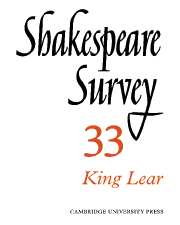Book contents
- Frontmatter
- King Lear: A Retrospect, 1939–79
- Some Conjectures on the Composition of King Lear
- The War in King Lear
- King Lear: Art Upside-Down
- ‘And that’s true too’: King Lear and the Tension of Uncertainty
- The Taming of the Shrew and King Lear: A Structural Comparison
- Medium and Message in As You Like It and King Lear
- Playing King Lear: Donald Sinden talks to J. W. R. Meadowcroft
- Hamlet’s Special Providence
- Antony and Cleopatra: ‘The Time of Universal Peace’
- Patterns of Motion in Antony and Cleopatra
- Theme and Structure in The Winter’s Tale
- Peter Street at the Fortune and the Globe
- English Actors at the Courts of Wolfenbüttel, Brussels and Graz during the Lifetime of Shakespeare
- Shakespeare at Stratford and the National Theatre, 1979
- The Year's Contributions to Shakespearian Study 1 Critical Studies
- 2 Shakespeare’s Life, Times, and Stage
- 3 Textual Studies
- Index
- Plate Section
Patterns of Motion in Antony and Cleopatra
Published online by Cambridge University Press: 28 March 2007
- Frontmatter
- King Lear: A Retrospect, 1939–79
- Some Conjectures on the Composition of King Lear
- The War in King Lear
- King Lear: Art Upside-Down
- ‘And that’s true too’: King Lear and the Tension of Uncertainty
- The Taming of the Shrew and King Lear: A Structural Comparison
- Medium and Message in As You Like It and King Lear
- Playing King Lear: Donald Sinden talks to J. W. R. Meadowcroft
- Hamlet’s Special Providence
- Antony and Cleopatra: ‘The Time of Universal Peace’
- Patterns of Motion in Antony and Cleopatra
- Theme and Structure in The Winter’s Tale
- Peter Street at the Fortune and the Globe
- English Actors at the Courts of Wolfenbüttel, Brussels and Graz during the Lifetime of Shakespeare
- Shakespeare at Stratford and the National Theatre, 1979
- The Year's Contributions to Shakespearian Study 1 Critical Studies
- 2 Shakespeare’s Life, Times, and Stage
- 3 Textual Studies
- Index
- Plate Section
Summary
More than twenty-five years ago, R. A. Foakes spoke out persuasively for a new approach to Shakespeare’s imagery that would go beyond the lines laid down by Caroline Spurgeon. Specifically, he appealed for attention to dramatic as well as poetic imagery, including props and stage effects; and for analysis and classification of images on bases other than subject-matter. By and large, critics have heeded the first call more than the second. Recent times have witnessed a new concentration on the direct imagery of stage production, and a corollary withdrawal from verbal imagery – for fear of committing the new cardinal sin, reading the play as a poem. Other critics remain faithful to ‘the poetry’, assuming that Hamlet can be apprehended in the same way as, say, Paradise Lost. Yet drama is a temporal art, much more so than poetry, and its essence is action. Perhaps one reason that image-critics of the traditional sort and theatre-oriented critics have little to say to each other is that the former are, for the most part, still attending only to image patterns created by static subject-matter, recurring objects like jewels or qualities like darkness. But verbs have their effect in Shakespeare’s language as well as nouns and adjectives. Images create other patterns through repeated motion, and it is this dynamic aspect of imagery that connects most naturally with stage movements and groupings.
Information
- Type
- Chapter
- Information
- Shakespeare Survey , pp. 113 - 122Publisher: Cambridge University PressPrint publication year: 1981
